What’s in Our Universe?
Unit 7 Reader

Grade 3 Core Knowledge Language Arts® • Skills Strand
Skills Strand
Grade 3
Core Knowledge Language Arts®

What’s in Our Universe? Unit 7 Reader
Creative Commons Licensing

This work is licensed under a Creative Commons AttributionNonCommercial-ShareAlike 3.0 Unported License.
You are free: to Share — to copy, distribute and transmit the work to Remix — to adapt the work
Under the following conditions:
Attribution — You must attribute the work in the following manner:
This work is based on an original work of the Core Knowledge® Foundation made available through licensing under a Creative Commons AttributionNonCommercial-ShareAlike 3.0 Unported License. This does not in any way imply that the Core Knowledge Foundation endorses this work.
Noncommercial — You may not use this work for commercial purposes.
Share Alike — If you alter, transform, or build upon this work, you may distribute the resulting work only under the same or similar license to this one.
With the understanding that:
For any reuse or distribution, you must make clear to others the license terms of this work. The best way to do this is with a link to this web page:
http://creativecommons.org/licenses/by-nc-sa/3.0/
Copyright © 2013 Core Knowledge Foundation www.coreknowledge.org
All Rights Reserved.
Core Knowledge Language Arts, Listening & Learning, and Tell It Again! are trademarks of the Core Knowledge Foundation.
Trademarks and trade names are shown in this book strictly for illustrative and educational purposes and are the property of their respective owners. References herein should not be regarded as affecting the validity of said trademarks and trade names.
Table of Contents What’s in Our Universe? Unit 7 reader Chapter 1: The Sun, Earth, and Our Solar System 6 Chapter 2: The Moon 16 Chapter 3: The Planets Closest to the Sun: Mercury, Venus, Earth, and Mars 24 Chapter 4: The Outer Planets: Jupiter, Saturn, Uranus, and Neptune 32 Chapter 5: Asteroids, Comets, and Meteors 40 Chapter 6: Galaxies and Stars 46 Chapter 7: Constellations 54 Chapter 8: Exploring Space 62 Chapter 9: A Walk on the Moon 74 Chapter 10: What’s it Like in Space? 82 Chapter 11: The Space Shuttle 92 Chapter 12: The International Space Station 98
Pausing Point (Additional Chapters for Enrichment) Chapter 13: Dr Mae Jemison 106 Chapter 14: Nicolaus Copernicus 114 Chapter 15: The Big Bang 120 Glossary for What’s in Our Universe? 129

The Sun, Earth, and Our Solar System 1
Look up in the sky at noon What do you see? If it is not cloudy, you will see the sun shining brightly in the sky
The sun provides energy—both light and heat energy The sun’s light and heat give life to plants and animals Without the sun, Earth would be freezing cold Have you ever wondered what the sun is made of or why it gives off so much light and heat?
6 What’s in Our Universe?
Chapter
The sun gives us light and heat energy.
What’s in Our Universe?

7
You may be surprised to know that the sun is a star It is in fact the closest star to Earth It is made up of different, hot gases How hot? A hot summer day on Earth is 100 degrees On the sun, it is 10,000 degrees! The sun stays that hot all the time! The sun’s gases create the light and heat energy it gives off Long ago, people believed that the sun moved around Earth This seemed to make sense Each morning at the start of the day, the sun rose in the east At the end of the day, the sun set in the west—exactly opposite from where it had came up To explain this change, people said the sun moved around Earth But now we know that this is not what really happens The sun does not move around Earth It is Earth that moves around the sun!
8 What’s in Our Universe?
A close-up of the sun
What’s in Our Universe?
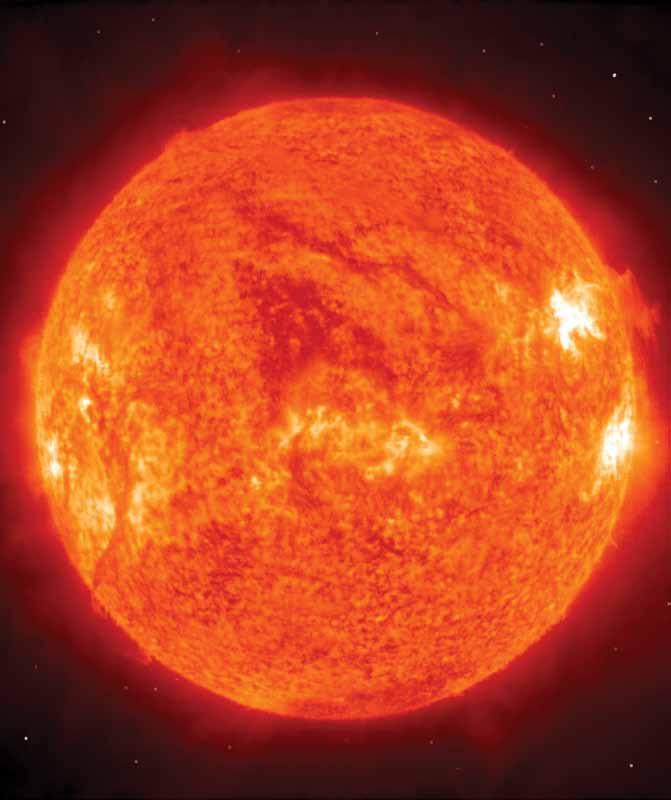
9
The sun is in the center of a group of eight planets All of these planets, including Earth, circle, or orbit, around the sun The sun, planets, and other objects in space that orbit the sun are called the solar system The word solar has the Latin root word sol, which means “the sun ” Everything in the solar system relates to the sun
10 What’s in Our Universe?
Planets orbiting the sun
What’s in Our Universe?
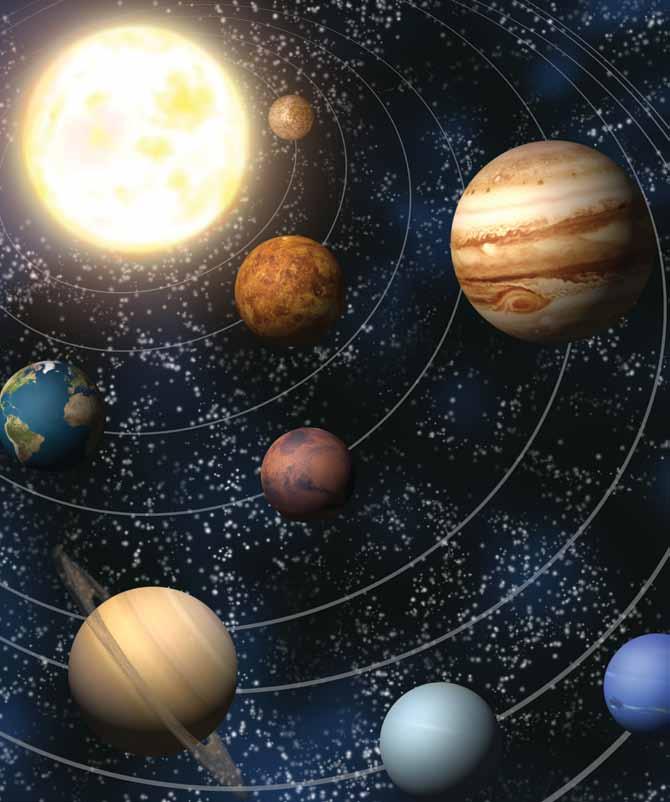
11
Our planet, Earth, moves in two ways We have just learned that Earth circles around the sun It takes about 365 days, which is one year, for Earth to orbit the sun
Earth also moves by spinning, or rotating, on its axis It is this spinning that makes day and night on Earth and the motion of the sun across the sky from sunrise to sunset It takes one day for Earth to make one complete rotation on its axis As Earth rotates and spins, different parts of it face the sun When the part facing the sun gets sunlight, it is daytime on that side of Earth The part that faces away from the sun gets no sunlight So, on that side of Earth, it is nighttime Did you know that when it is daytime where we live, it is nighttime on the other side of Earth?
12 What’s in Our Universe?
Day Night
Earth spins on its axis. On the side of Earth facing the sun, it is daytime. On the side facing away from the sun, it is nighttime.
What’s in Our Universe?
13
When Earth rotates on its axis, it is tilted At certain times of the year, one part of Earth is tilted toward the sun The sunlight is more direct and it feels hotter For people living on this part of Earth, it is summer For people living on the part of Earth tilted away from the sun, there is less sunlight and it is winter So, when it is summertime for us, there are people living on other parts of Earth where it is winter! So, the fact that Earth is tilted on its axis is what creates the seasons of the year
14 What’s in Our Universe?
Summer
Winter
When Earth is tilted on its axis towards the sun, it is spring and summer. When Earth is tilted on its axis away from the sun, it is fall and winter.
What’s in Our Universe?
15
Chapter The Moon 2
Look up in the sky at night What do you see? If it is not cloudy, you may be able to see the moon
When you see the moon at night, it might look white It might look gray or silver Sometimes, it seems to shine and glow But the moon does not give off light the way the sun does The moon is a ball of rock that gives off no light of its own It simply reflects light from the sun That means light from the sun hits the moon and bounces off
16 What’s in Our Universe?
Our moon is easily visible on most clear nights.
What’s in Our Universe?

17
You already know that Earth orbits around the sun But did you know that the moon orbits around Earth? It takes just about one month for the moon to completely circle Earth If you look up at the night sky each night of the month, you may think that the size and shape of the moon is changing However, the size and shape are not really changing The moon is still a round ball It looks different at different times of the month because of the way the light from the sun is reflected and how much of the moon we can see from Earth
18 What’s in Our Universe?
This chart shows the phases of the moon. It shows what you might see if you looked at the moon each night for a month. You can read the chart just like you would read a book. Start at the top and go from left to right. When you finish reading the first row, go on to the next one. You can see how the moon seems to change during the month.
19 What’s in Our Universe?
The way that Earth, the moon, and the sun move can also make other interesting things to look at in the sky When Earth, the moon, and the sun all move together in a direct line, something called an eclipse can take place
We can see two kinds of eclipses from Earth One kind happens when the moon gets in between the sun and Earth When that happens, we can’t see the sun for a while At least, we can’t see part of it We call this a solar eclipse or an eclipse of the sun
20 What’s in Our Universe?
During an eclipse of the sun, the moon moves between Earth and sun and blocks out the sun.
What’s in Our Universe?

21
The other kind of eclipse, called a lunar eclipse, also involves the sun, the moon, and Earth It takes place when the moon passes behind Earth and into its shadow In the image on the next page, you can see that a shadow covers part of the moon It is Earth’s shadow that you see Earth has blocked out the sun and left part of the moon in darkness
Eclipses do not happen often because the sun, Earth, and the moon all have to line up just right Solar eclipses can only be seen from a narrow strip of Earth at a time While they happen once or twice a year, it is very, very rare to see one Eclipses of the moon happen more often, several times each year They can be seen from half of Earth at a time, so are more often visible
Whether or not you can see an eclipse depends on where you are on Earth You must never look directly at a solar eclipse The sun is very bright and could burn your eyes But, it is safe to look at an eclipse of the moon If an eclipse is predicted, it is usually big news, so you will likely hear about it
22 What’s in Our Universe?
The moon during a lunar eclipse
What’s in Our Universe?

23
Chapter
The Planets Closest
to the Sun: Mercury, Venus, Earth, and Mars 3
Our planet Earth is one of eight planets in our solar system that orbit around the sun The other planets are Mercury, Venus, Mars, Jupiter, Saturn, Uranus, and Neptune People have been looking at the planets for thousands of years People from Mesopotamia, the Greeks, Mayans, Incas, and Aztecs were all interested in the planets They used just their naked eye to study the planets Now, we have telescopes and other tools that help us get a better look at the planets
24 What’s in Our Universe?
A telescope
What’s in Our Universe?
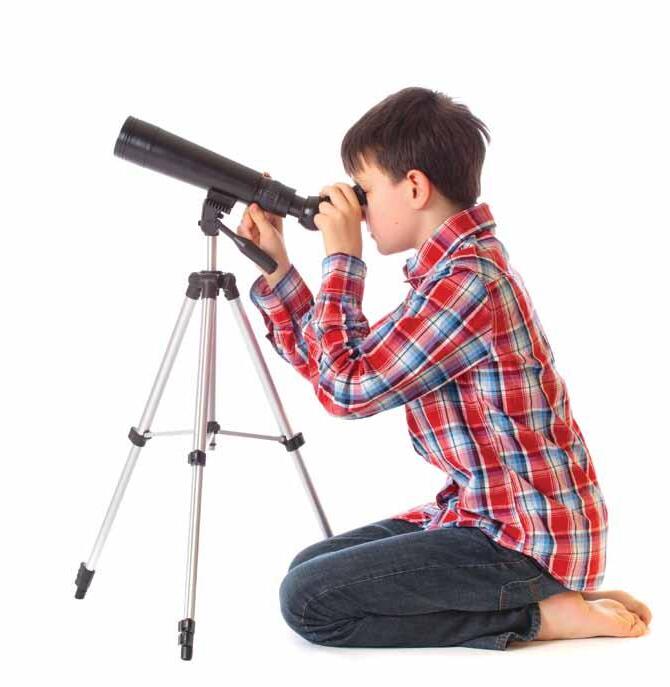
25
The four planets closest to the sun—Mercury, Venus, Earth, and Mars—are small planets These planets have a rocky, or solid, surface
Mercury and Venus are closer to the sun than Earth The other planets are farther away
Earth needs 365 days to make one orbit around the sun That is the length of one year on Earth
The closer a planet is to the sun, the less time it needs to make an orbit around the sun Mercury is the closest planet to the sun It needs just 88 days to make one orbit Venus is the next closest to the sun It needs just 225 days to make an orbit The planets that are farther away take much longer It takes Neptune 165 years to orbit the sun!
26 What’s in Our Universe?
The sun and planets
What’s in Our Universe?

27
Besides being closest to the sun, Mercury is the smallest of all the planets The English name for the planet comes from the Romans They named the planet after the Roman god Mercury The Greek name for this same god is Hermes
Venus is the second planet from the sun and is closest to Earth This planet was named after the Roman goddess of love For a long time, scientists thought that Venus might be a lot like Earth After all, it is close to Earth It is about the same size as Earth and it is covered with clouds, like Earth But this idea turned out to be wrong, too We know now that Venus and Earth are different in lots of ways
Scientists had to change their ideas to fit the new facts They have now concluded that Venus is much hotter than Earth It would not be a good place for us to live or even visit
28 What’s in Our Universe?
Mercury (top) and Venus

What’s in Our Universe?
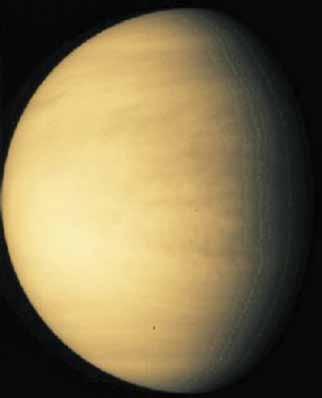
29
Mars is the fourth planet from the sun It is named after the Roman god of war When you look at Mars in the night sky, it looks quite red This is because the rocks on Mars contain rust
Many space probes and robots have landed on Mars They have taken photographs and also dug up rocks
One probe that went to Mars not long ago found some ice That was big news Ice is frozen water If there is water on Mars, there might be life Some experts argue that nothing could live on Mars They say it is too cold and too dry Others think there might be life on Mars They think there might be something alive down under the rocks Still others think there might have been life on Mars at one time but there isn’t any now
30 What’s in Our Universe?
Mars
What’s in Our Universe?
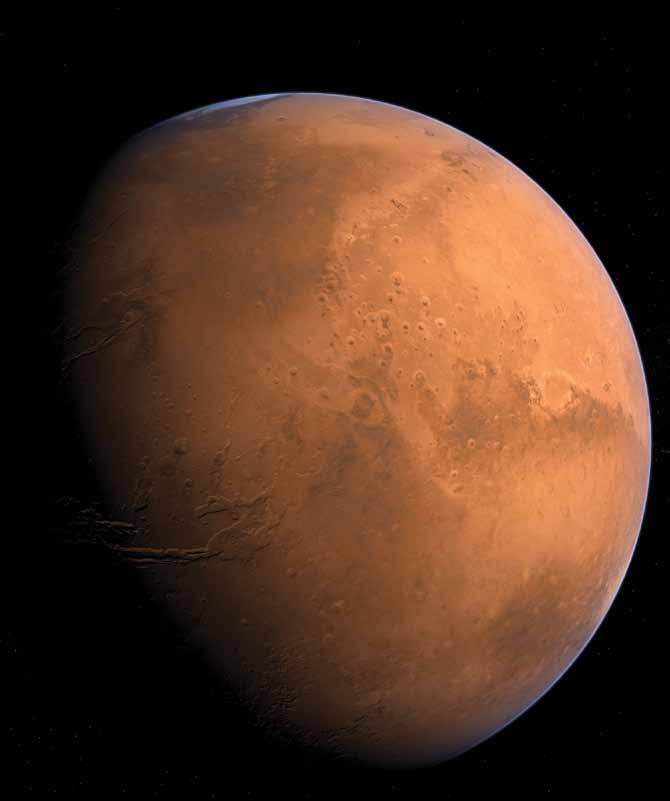
31
Chapter The Outer Planets: Jupiter,
4
Saturn, Uranus, and Neptune
Do you remember the names of the four planets closest to the sun? If you said, “Mercury, Venus, Earth, and Mars,” you are right! There are four more planets called the outer planets So there are eight planets in all Jupiter is the very next planet after Mars After Jupiter come Saturn, Uranus, and Neptune in that order Neptune is the planet that is farthest from the sun Uranus is difficult to see with the naked eye and Neptune is impossible to see without help Neptune is only visible using a telescope
32 What’s in Our Universe?
Our solar system: the sun and eight planets





















































What’s in Our Universe?




33
The outer planets are very large and are mostly made of gas Scientists often call these planets gas giants Of all the planets, Jupiter is the largest: 1,300 Earths could fit inside Jupiter! It is made mostly of hydrogen gas, the most common gas in the universe
The gases on Jupiter seem to be blowing around In the image of Jupiter on the next page, you can see the giant, red spot It looks like an eye! Experts think it is a big wind storm, like a huge hurricane
Jupiter also has 63 known moons that orbit it
Some of these moons are very large, even larger than Earth’s moon
34 What’s in Our Universe?
Jupiter and some of its moons
What’s in Our Universe?

35
Saturn is known for its many large rings that orbit the planet These rings are made of ice and dust The ice reflects light and makes the rings glow Saturn also has many moons that orbit it
36 What’s in Our Universe?
Saturn and its rings
What’s in Our Universe?
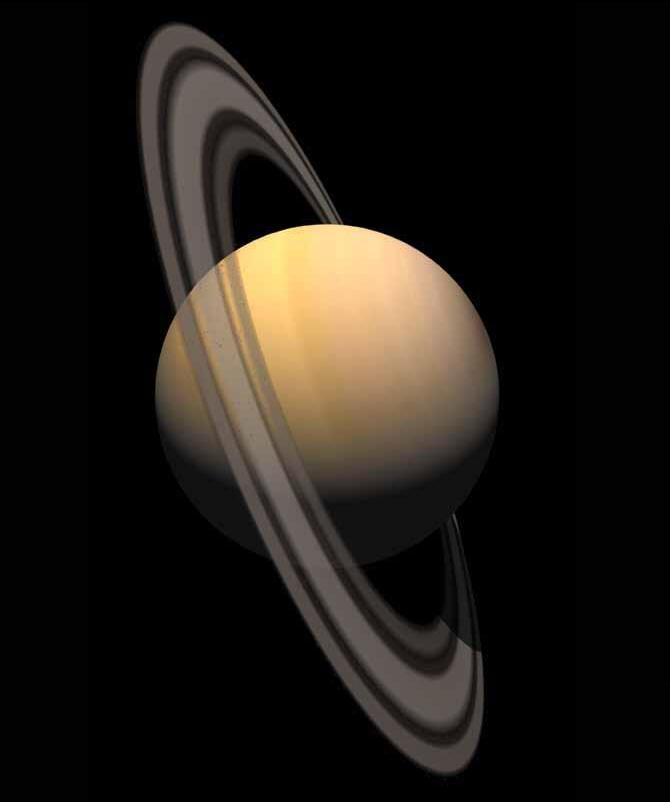
37
The last two planets are Uranus and Neptune
These planets are the farthest from the sun so they are very cold Uranus and Neptune also have rings, but they aren’t easily seen like Saturn’s Both planets also have moons
So now you know the names of all eight planets
Try asking the adults in your family how many planets there are They may tell you that there are nine planets When the adults in your family were in school, people said that there was a ninth planet called Pluto But in 2006, scientists decided that Pluto did not have all of the characteristics needed to be classified as a planet They removed Pluto’s name from the list of planets, so now there are only eight planets
38 What’s in Our Universe?
This is Neptune as it might look if seen from one of its moons. The shadow of another moon makes a dark spot on the planet’s surface.
What’s in Our Universe?

39
Chapter Asteroids, Comets, and Meteors 5
There are other objects that orbit the sun in the solar system besides the planets Millions of space rocks called asteroids also orbit the sun Asteroids are made of rock, metal, and sometimes ice Many asteroids are found orbiting the sun between the planets Mars and Jupiter They cluster together in a shape like a belt as they orbit the sun This part of the solar system is called the asteroid belt
40 What’s in Our Universe?
Top: An artist’s image of an asteroid belt around a star

Bottom: An up-close image of an asteroid from our solar system
What’s in Our Universe?

41
Comets also orbit the sun Comets are made mostly of ice and dust When a comet gets close to the sun, the sun’s heat causes some of the comet to change into a gas This gas streams off the end of the comet like a tail
The most famous comet is Halley’s Comet It is named for the British scientist Edmund Halley who first discovered it Halley’s Comet is visible from Earth with the naked eye every 76 years It was last seen in 1986 Can you figure out when it will be seen again?
42 What’s in Our Universe?
A comet in the night sky
What’s in Our Universe?

43
Other kinds of space rocks called meteoroids are also found throughout the solar system When a meteoroid enters Earth’s atmosphere, we call it a meteor Small pieces of the meteor burn brightly and look like a white trail across the sky when viewed from Earth Sometimes people call this a “shooting star ” Have you ever seen one? A meteor “shower” is when many meteors can be seen falling in the sky on the same night Sometimes they last over several nights It’s an amazing space show!
If a meteor doesn’t fully burn up in the atmosphere, it falls to Earth and can make a large hole called a crater Pieces of a meteor found on the ground are meteorites
44 What’s in Our Universe?
Meteor Crater in Arizona formed when a meteorite hit Earth. Notice the road and buildings to the left of the crater. This crater is very big!

What’s in Our Universe?

45
An artist’s drawing of a meteor shower at night
Galaxies and Stars 6
Look up in the sky at night What do you see besides the moon? If it is not cloudy, you may be able to see lots of stars glittering in the sky
Remember that the sun is also a star The stars in the night sky do not look like the sun They do not look as big or as bright But they are, in fact, very much alike The stars in the night sky are big balls of hot gas, just like the sun
So why don’t they look the same? The night stars are much, much farther away from Earth than the sun That is why they look like tiny specks of light If we could get close to the stars, they would look bigger, brighter, and more like the sun But the stars we see at night are so far away that no one from Earth has ever been able to get close to them
46 What’s in Our Universe?
Chapter
Stars in the night sky
What’s in Our Universe?

47
Scientists who study the stars and outer space are called astronomers The Greek root word astron means star The prefix astro is used in many other English words
All stars are big balls of hot gas, but astronomers have discovered that stars differ in many ways Stars can be different sizes and colors Some stars are closer to Earth than others and some stars are hotter than others Stars that are the hottest and closest to Earth appear brighter than other stars
48 What’s in Our Universe?
All stars are made of gases, but they can differ in size, color, and brightness.
What’s in Our Universe?

49
Astronomers also discovered that stars cluster together in large groups A large group of stars that cluster together in one area is called a galaxy. There are billions and billions of stars in one galaxy That’s a lot of stars!
The galaxy to which our sun and solar system belong is called the Milky Way Galaxy It has a spiral shape when viewed from space From Earth, it looks like a “milky” band of white light
50 What’s in Our Universe?
The Milky Way as it appears in the night sky
What’s in Our Universe?
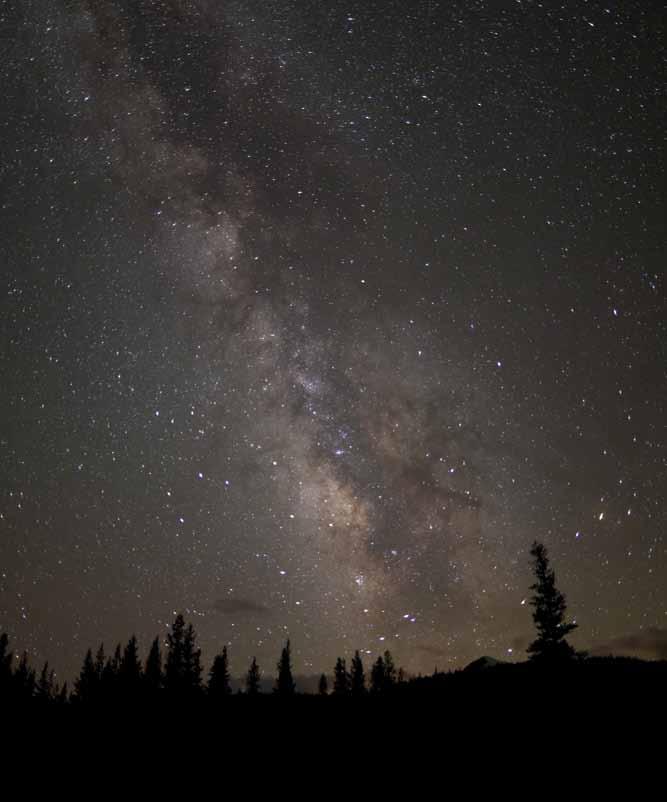
51
The nearest spiral galaxy to the Milky Way Galaxy is called the Andromeda Galaxy It is billions and billions of miles from the Milky Way Galaxy There’s that number billions again You have probably heard of a million before A million is a huge number So what’s a billion? It’s one thousand million! It is safe to say that the Andromeda Galaxy is a long, long, long way away! Even so, it is sometimes possible to see the Andromeda Galaxy at night
Scientists think there are billions of galaxies in the universe There’s that number billions again There are billions of stars in each galaxy and billions of galaxies in the universe—that is almost more than you can think about!
52 What’s in Our Universe?
Andromeda Galaxy
What’s in Our Universe?
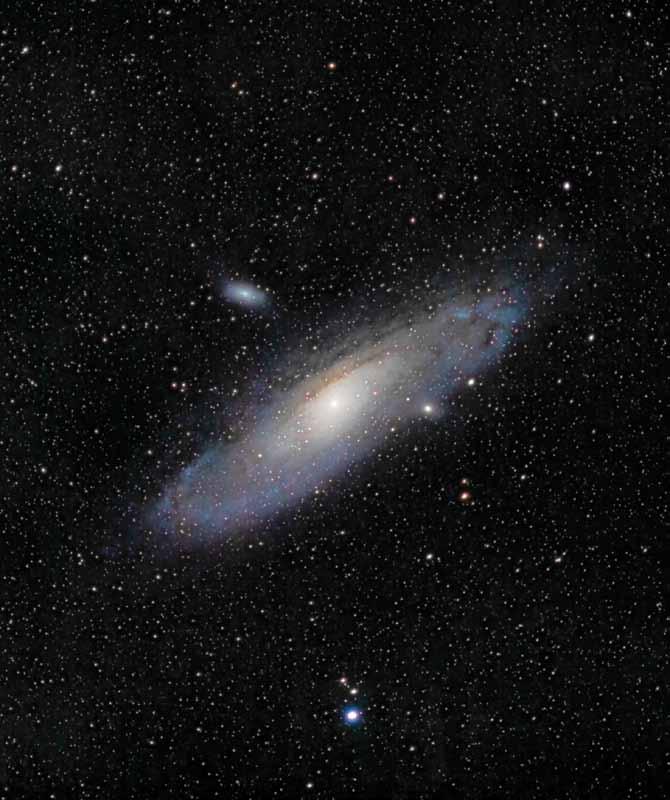
53
Constellations 7
Go outside one night and look at the stars Of the billions of stars in our galaxy, it is possible to see only 2,000 with the naked eye When you first look at them, you might not see much They might look like just a bunch of tiny dots
Look a little closer You will see that some stars shine more brightly than others Focus on the bright stars Which ones really jump out at you?
Then, focus on the spaces in between the bright stars Ask yourself, “What would it look like if I drew lines from one bright star to the next? What would it look like if I were to connect the dots? Would I see any shapes? Would I see any patterns?”
Since ancient times, people have been studying the stars When ancient people looked at the stars, some seemed to be closer together and formed patterns
54 What’s in Our Universe? Chapter
On a clear night away from city lights, you can see the stars that fill the night sky.
What’s in Our Universe?

55
One of the first people to describe these star patterns, called constellations, was a man named Ptolemy [TO-lə-mee] He picked out the brightest stars and traced lines from one star to the next He saw all types of shapes and patterns One looked like a bull He saw another that looked like a crab A third looked like a bear In all, he found 48 constellations Much later, 40 more constellations were added to Ptolemy’s list Today, astronomers say there are 88 constellations that can be seen in the night sky
On the next page is a drawing of a constellation that Ptolemy described It is called Ursa Major or Big Bear The white dots or circles stand for the stars in the constellation The dotted lines connect the stars and trace the pattern so you can see the shape Do you see a Big Bear in the pattern? It does not look exactly like a real bear So, you may need to imagine that it looks like a bear Hint: its head is to the left with its nose being the star that is on the far left
56 What’s in Our Universe?
Ursa Major
What’s in Our Universe?
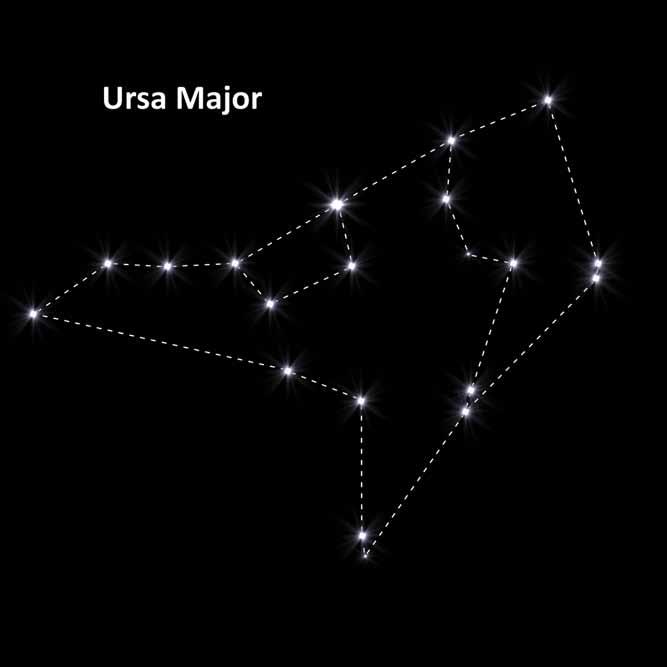
57
Within Ursa Major, there are seven very bright stars that form another small group of stars called the Big Dipper Look at the image at the top of the next page Can you see why it is called the Big Dipper? When you trace a line from star to star, the shape looks like a dipper. A dipper is like a ladle you can use to scoop something into a bowl The stars on the left look like the handle The stars on the right look like the scoop
Ptolemy also described another constellation called Ursa Minor or Little Bear This constellation is also made up of seven stars In the image on the bottom of the next page, the seven dots stand for the stars An artist has added a drawing of a bear to help you better imagine how the star pattern looks like a bear
58 What’s in Our Universe?
The Big Dipper
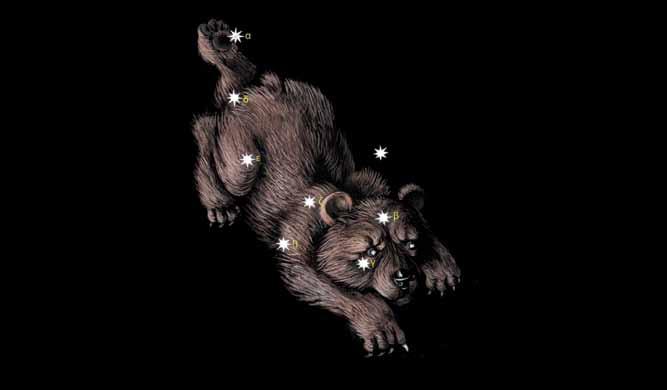
What’s in Our Universe?
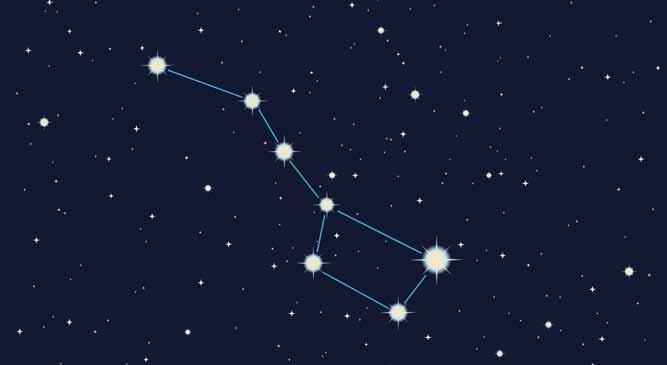
59
Ursa Minor
Ursa Minor is also called the Little Dipper The brightest star at the end of the handle is called Polaris Can you see it? Polaris stays in the same place in the night sky all year long (Other stars are found in different places in the sky at different times of the year ) Polaris’s place in the sky is almost directly over the North Pole of Earth By finding Polaris, also called the North Star, you can find the direction north and the other directions In ancient times, sailors and explorers used this star to find their way when they traveled
Try to find Polaris the next time you look at the night sky Start by first looking for the Big Dipper because it is easier to find Then, find the two
“pointer” stars at the edge of the Big Dipper’s scoop Then, pretend there is a long arrow pointing the same way as the pointer stars The first star you will see at the end of the arrow is Polaris
60 What’s in Our Universe?
What’s in Our Universe?

61
The ‘pointer’ stars of the Big Dipper pointing to Polaris, the North Star
Exploring Space 8
As you have learned in the last chapters, people have been interested in studying space since ancient times It was possible to see only some stars and planets with the naked eye Since they were far, far away, it was impossible to see anything in very much detail
In 1609, an astronomer named Galileo [ga-li-laeoe] created a telescope that he used to observe the night sky Galileo’s telescope made things appear three times larger Using his telescope, he discovered four of the many moons that orbit the planet Jupiter He also observed the planet Saturn and the Milky Way
62 What’s in Our Universe? Chapter
What’s in Our Universe?
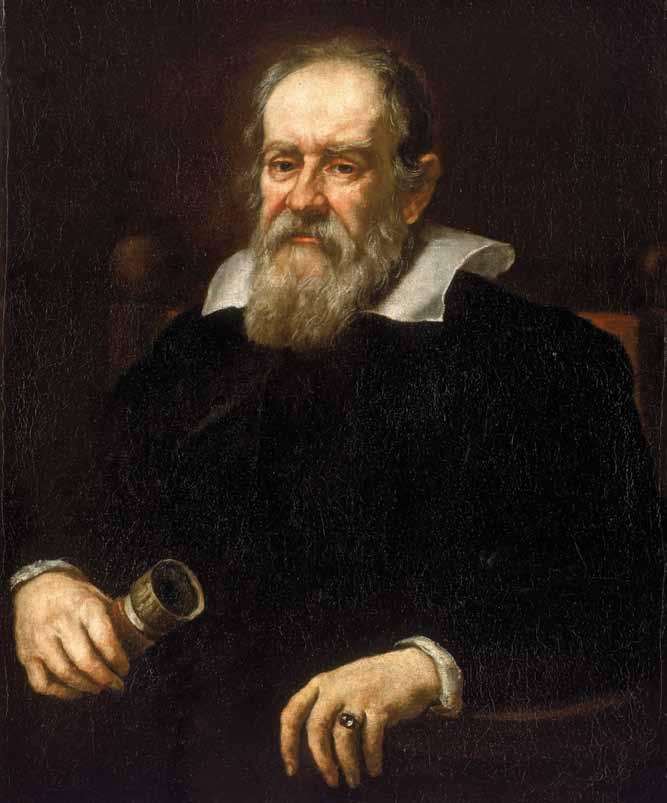
63
A portrait of Galileo holding a telescope
Since Galileo’s time, scientists have created more and more powerful telescopes Some telescopes are housed in large observatories on Earth Often, these observatories are on the top of mountains, far away from any cities or lights This allows astronomers to clearly see the stars and planets
64 What’s in Our Universe?


65
an observatory on top of a mountain helps to get a better view of the sky.
What’s in Our Universe? Building
Other telescopes are launched into space using rockets They travel far above Earth and have a better view of the universe than telescopes on Earth One of these telescopes is the Hubble Telescope It was launched in 1990 by NASA, the American group of scientists who study outer space The Hubble Telescope is still in space today, orbiting Earth Since its launch, it has sent back thousands of photos to NASA Hubble’s photos have led to many new discoveries about the universe For example, using photos from Hubble, scientists now think that the universe is about 13 to 14 billion years old!
66 What’s in Our Universe?
The Hubble Telescope orbits Earth above its atmosphere.
What’s in Our Universe?
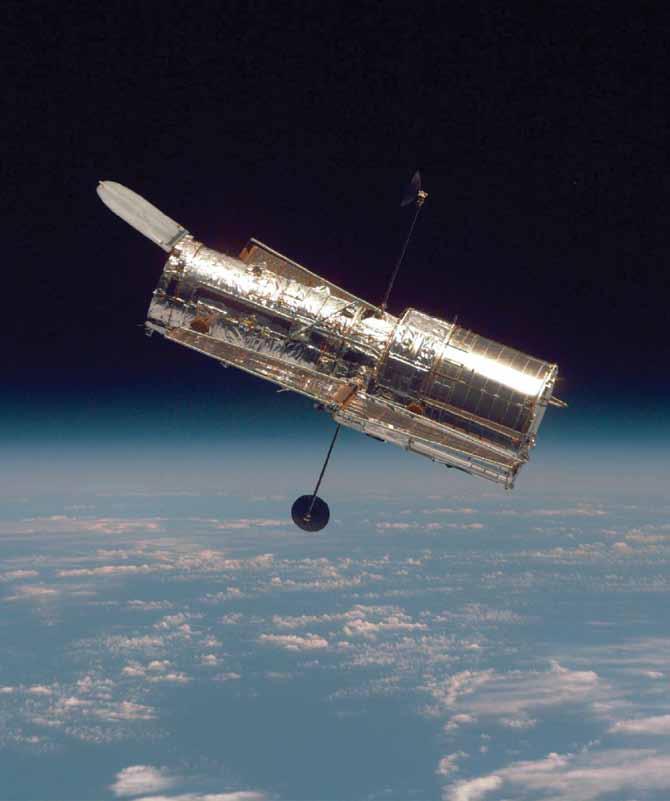
67
Besides sending telescopes into space, NASA has also launched rocket ships into space Scientists believed it was too dangerous for humans to ride the first rocket ships into space They did not know what effects space travel might have on humans So, NASA first sent apes into space on rocket ships “Why apes?” you might ask Think back to what you learned in a previous reader about animals Apes are mammals and belong to the same group of animals, called primates, as humans By studying the apes, scientists hoped to learn how space travel might affect humans In 1961, NASA sent the first American astronaut into space on a rocket ship His name was Alan Shepard He stayed in space for only 15 minutes
68 What’s in Our Universe?
Top image: Ham, one of the first apes launched into space

Bottom image: Alan Shepard was the first American astronaut in space.
What’s in Our Universe?

69
After 1961, NASA sent more manned flights into space These flights orbited Earth but did not stop or land anywhere in space Then, in 1969, the United States sent a rocket ship to the moon The rocket ship was called Apollo 11
70 What’s in Our Universe?
What’s in Our Universe?

71
Apollo 11 fires its rockets during lift-off.
Have you ever tried to throw a ball up in the air? The ball goes up at first Then, it comes back down No matter how hard you throw it, it comes back down because of gravity Gravity is a force of attraction that pulls things toward one another Earth’s gravity pulls the ball back down to Earth
Earth’s gravity is a challenge for rocket ships like Apollo 11 In order to fly off into outer space, the rocket ship has to push up with a lot of force It has to push up with so much force that gravity cannot pull it back down
Apollo 11 fired a lot of strong rockets It lifted off and went up slowly at first Then, it got faster and faster This is what it looked like after a few seconds After just a few seconds more, it shot up out of Earth’s atmosphere and into outer space
72 What’s in Our Universe?
Apollo 11 shooting up into space
What’s in Our Universe?
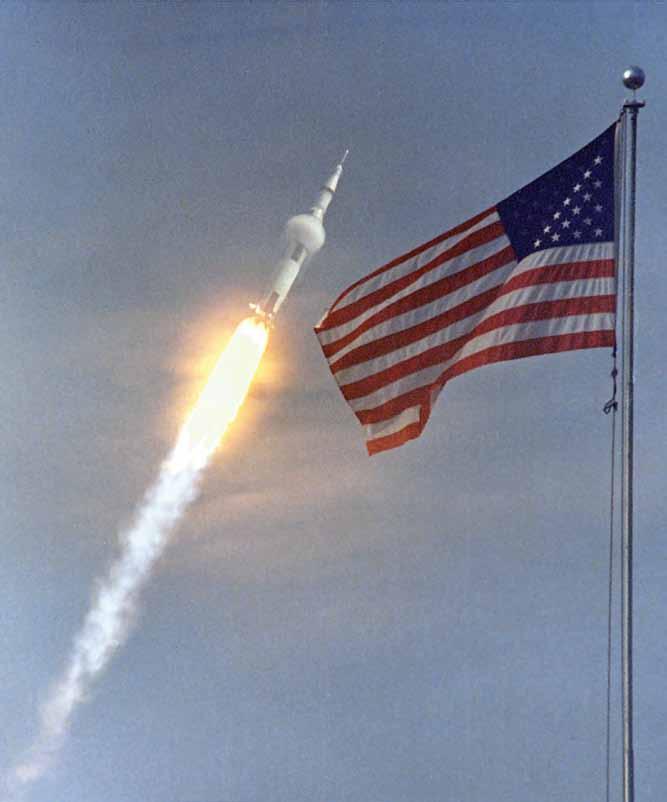
73
Chapter A Walk on the Moon 9
Once Apollo 11 was up in space, the astronauts had to steer it to the moon There were three astronauts on Apollo 11 You can see them in the image on the next page Each had a job to do One of them was in charge of flying the spaceship, called Columbia The other two had to get into a landing craft called the Eagle Then, they had to steer it down and land it on the moon
74 What’s in Our Universe?
The Apollo 11 astronauts
What’s in Our Universe?

75
The astronaut who had to steer the Eagle was named Neil Armstrong He had to find a good, flat spot to land He also had to set the Eagle down gently
Lots of people tuned in to watch Armstrong and the Eagle on live TV At first, Armstrong had a hard time getting the Eagle to go where he wanted it to go But, in the end, he landed it just fine
Armstrong sent a message back by radio: “The Eagle has landed!”
The crowds watching it on TV went wild They danced and sang They shouted and waved the United States flag For the first time ever, humans had landed on the moon!
What happened next was even more amazing The astronauts went for a walk on the moon!
76 What’s in Our Universe?
Here is one of the Apollo 11 astronauts walking on the moon. Can you see his footprints?
What’s in Our Universe?

77
There is no air for breathing on the moon It is also very cold So, the astronauts could not just walk out in shorts and a T-shirt They had to put on space suits like the one in the image on the next page They had to wear masks They had to carry tanks full of air for breathing
Armstrong went out first He went down the steps of the Eagle until he was on the last one Then, he made a little hop He landed on the moon and kicked up a little moon dust Then, he said, “That’s one small step for man, one giant leap for mankind ” Another astronaut joined Armstrong on the moon His name was Buzz Aldrin
Once again, people watching it on TV cheered
They were proud that the United States had put a man on the moon!
78 What’s in Our Universe?
Buzz Aldrin plants the U.S. flag on the moon.
What’s in Our Universe?

79
While Armstrong and Aldrin were on the moon, pilot Michael Collins stayed on a part of the spaceship that was still orbiting the moon Armstrong and Aldrin spent more than 21 hours on the moon They found that it was easy to move about on the moon, which has less gravity than Earth They could jump up high and seemed to float down slowly They used different tools to explore the moon They knew the scientists back on Earth were hoping to learn new information about the moon They dug up samples of moon rocks to take back to Earth
After exploring the moon, Aldrin and Armstrong got back in the Eagle They lifted off They met up with Michael Collins on board the other part of the spaceship Then, all three of them flew back to Earth The spaceship came speeding back from space and splashed down into the sea A Navy ship came to pick up the astronauts and take them back to NASA
80 What’s in Our Universe?
Splashdown of Apollo 11
What’s in Our Universe?

81
What’s it Like in Space? 10
Since Apollo 11, many more astronauts have traveled in space Scientists have learned that there are many differences between Earth and space One of the biggest differences has to do with gravity Remember that gravity is a force of attraction that pulls things toward one another The force of gravity on Earth is pretty strong Even the best jumpers can only jump a few feet off the ground (Try it and see!)
82 What’s in Our Universe? Chapter
Want to jump high? You will have to fight against gravity.
What’s in Our Universe?

83
Remember that on the moon, astronauts Aldrin and Armstrong were easily able to jump up high They didn’t come down quickly either Instead, they seemed to float down slowly That was because the force of gravity on the moon is not as strong as on Earth The moon is not as big as Earth So the force of gravity is not as strong on the moon
If you think that is cool, wait until you read what happens out in space, away from the moon or planets Out in space, astronauts do not feel the effects of gravity They and their spaceship are moving freely in space Since the astronaut and spaceship are moving freely together, the astronauts look and feel as if they are floating!
84 What’s in Our Universe?
This astronaut is inside a spaceship in space, where the force of gravity is less.
What’s in Our Universe?
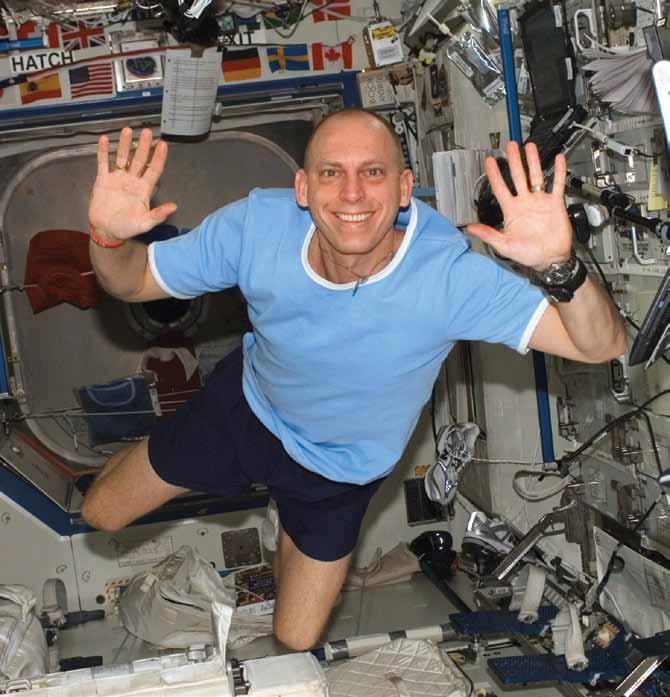
85
Up in space, lots of things are different You can do a flip and not worry about whether you will make it all the way around before you come down!
86 What’s in Our Universe?
When you are free of the effects of gravity, it is easier to do flips and cartwheels.
What’s in Our Universe?

87
Eating is different in space, too I’ll bet when you eat lunch at school, your food stays where you put it If you set it on a table, it stays there until you pick it up The force of gravity holds it down But if you were up in space, you and your food would be moving freely together If you let go of it, your food might drift away!
88 What’s in Our Universe?
Look, no hands! These astronauts’ lunches appear to be floating!
What’s in Our Universe?

89
There are other differences in space besides less gravity Do you remember that the astronauts on the moon had to carry tanks of air for breathing? Another way outer space is different from Earth is that there is no air or oxygen at all in outer space Look again at the image on page 87 of the astronauts inside the spaceship The astronauts are not carrying tanks of air That’s because oxygen is being pumped inside the spaceship
Since there is no air in space, you also do not hear sounds in outer space It is also very cold in space The astronauts must train many months before going into space so they know what to expect Do you think you would like to go into space some day?
90 What’s in Our Universe?
This is what Earth looks like from the moon. Can you name some ways that being in space is different from being on Earth?
What’s in Our Universe?

91
The Space Shuttle 11
Interest in manned space exploration soared after Apollo 11 Other astronauts went to the moon But scientists were also interested in exploring other parts of space beyond the moon It was very expensive and took a lot of time to build and send spaceships into space Do you remember that when Apollo 11 returned from space, it landed in the sea? It was not able to land safely on the ground, so this type of spacecraft always had to land in the sea Once it landed in the sea, this kind of spacecraft could not be used again
In 1981, a reusable spacecraft, called a space shuttle, was built It was able to fly up into space and then zoom back down to Earth When it returned to Earth, the pilot was able to land the spacecraft on a runway almost like an airplane It glided down from space and landed on a runway, but it had to be a very long runway
92 What’s in Our Universe? Chapter
A space shuttle lifts off
What’s in Our Universe?

93
The space shuttle was flown back into space again and again It shuttled back and forth between Earth and space That is why it was called the space shuttle
The image on the previous page shows the launch of a space shuttle The space shuttle itself is the white part that looks like a jet plane The other parts are booster rockets The booster rockets helped the space shuttle get off the ground They helped the space shuttle overcome Earth’s gravity Once the space shuttle was up into space, it dropped the booster rockets because it no longer needed them
94 What’s in Our Universe?
A space shuttle in orbit above Earth
What’s in Our Universe?
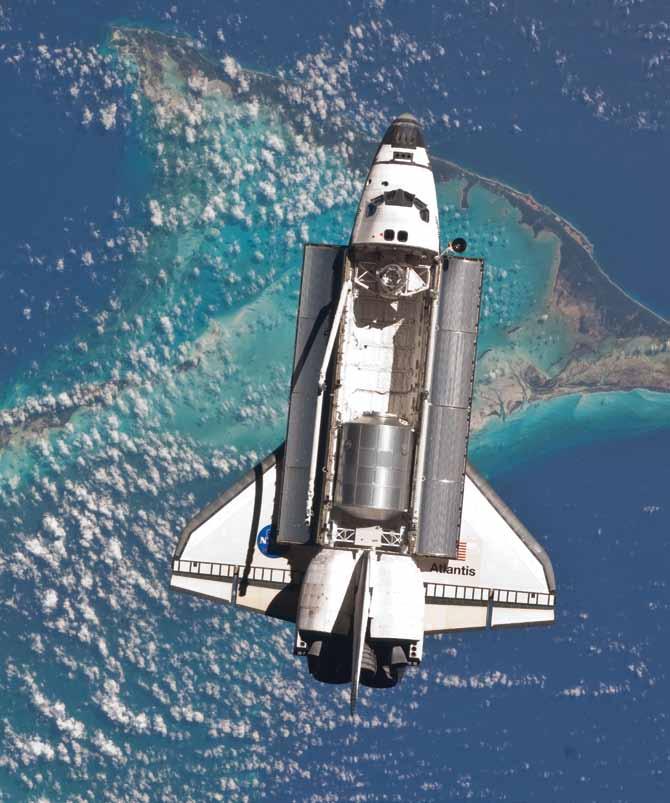
95
In the thirty years between 1981 and 2011, different space shuttles carried astronauts up into space on many missions The space shuttle was also used to bring research equipment and tools into space The astronauts did many experiments to find out more about space Scientists were especially interested in learning about what effect the lack of gravity would have on humans and other living things
The space shuttle was also used to help build an amazing space station Astronauts could live at the space station for months at a time Often, the space shuttle carried supplies back and forth from Earth to the space station It also provided a ride home to Earth when it was time for the astronauts to return
The last space shuttle mission took place in July 2011 NASA scientists and Americans were proud of everything the astronauts had accomplished in thirty years With the end of the space shuttle missions, NASA is planning other ways to explore space Those plans include launching unmanned probes and satellites NASA scientists hope to learn more about the moon’s gravity and are even talking about trying to explore asteroids!
96 What’s in Our Universe?
What’s in Our Universe?

97
A space shuttle comes in for a landing.
The International Space Station 12
Would you like to have a bedroom in outer space? Some astronauts do!
The United States and other countries use the space shuttle to send astronauts to an international space station The space station orbits Earth Three astronauts can live there at one time They stay for six months at a time This image shows the space station
98 What’s in Our Universe?
Chapter
The space station orbits Earth.
What’s in Our Universe?

99
The space station orbits far above Earth So the astronauts in the space station don’t feel the effects of gravity like we do on Earth When we lift our arms and legs here on Earth, we have to work against gravity That is good for us It helps us stay in shape But astronauts in space don’t have the effects of gravity to work against They do not get much of a workout from drifting around They have to run at least once a day to stay in good shape In this image, you can see an astronaut jogging in space
100 What’s in Our Universe?
Astronauts have to jog in space to stay in shape.
What’s in Our Universe?

101
These two men are sleeping in space They don’t feel the effects of gravity so they are moving freely within the spaceship This means they can sleep right side up or upside down It is all the same Do you think you would like sleeping this way?
102 What’s in Our Universe?
What’s in Our Universe?

103
These two astronauts are taking a nap in space.
Taking a shower in space is tricky On Earth, the water comes out of the spout It falls down and splashes on your body Then, it runs off But this is not what happens in space! In space, you have to rub the water on your skin Also, it does not just drip off You have to scrape it off You have to shower in a little pod The pod keeps the water you scrape off your skin from drifting off in the air If it drifted off, it might cause problems It might mess up the computers and equipment inside the space station
You can see that lots of things are different when you live in space That is why leaving the space station and coming back to Earth can be hard It takes time for the astronauts to get used to Earth again After months in space, they struggle with the gravity on Earth Their arms and legs feel heavy They find it hard to stand up They feel off balance But in a few weeks, they begin to feel normal again Sometimes when they look up at the sky, they even feel a little homesick for their home in outer space
104 What’s in Our Universe?
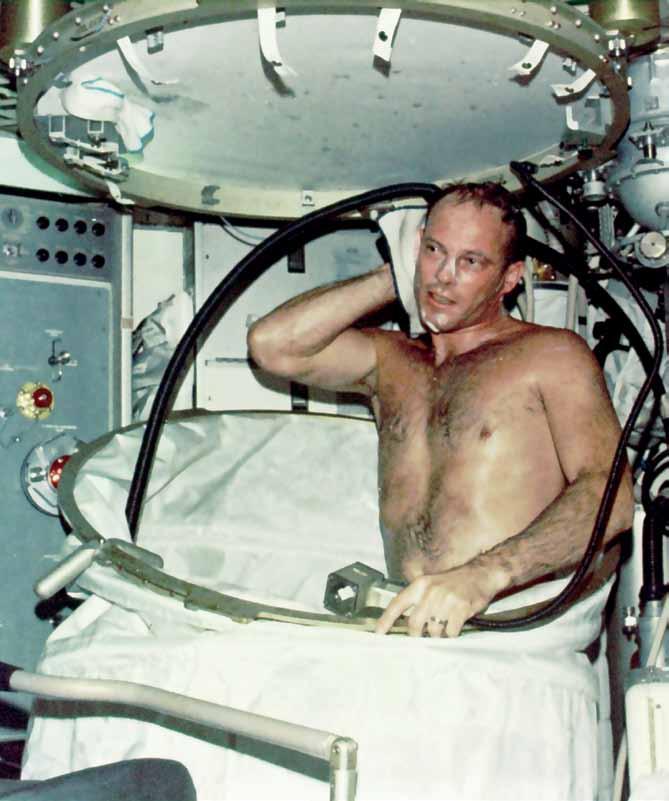
105
What’s in Our Universe?
An astronaut taking a space shower
Chapter Dr. Mae Jemison 13
Do you know what a role model is? A role model is someone who sets an example for others by the way he or she lives Many students admire people who are famous athletes, movie stars, or singers and use them as role models They see them on TV, in newspapers and in magazines, and decide they want to be like them But some of the best role models are people that you probably would not see on TV or in newspapers They have jobs such as doctors, teachers, or policemen Some are scientists and astronauts One such person is Mae Jemison
106 What’s in Our Universe?
What’s in Our Universe?
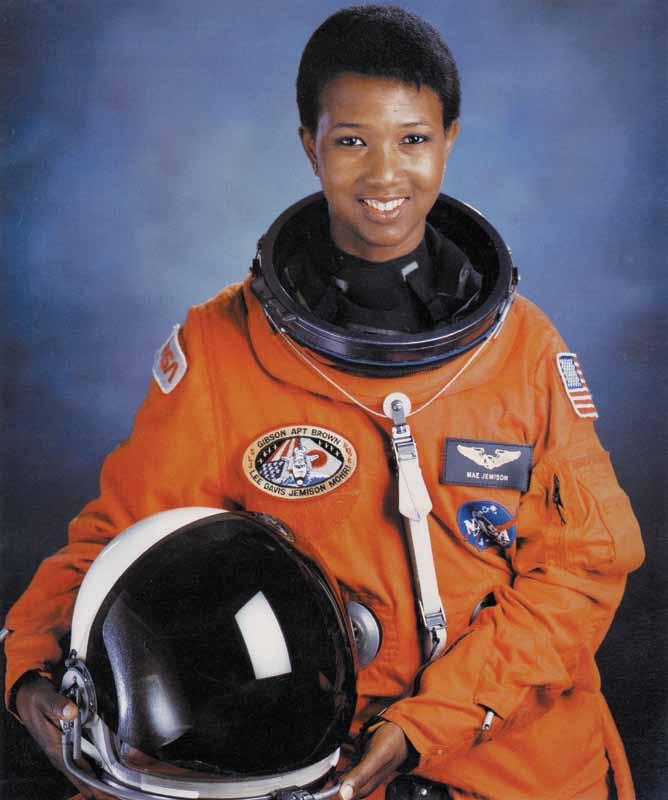
107
Mae Jemison
Mae Jemison was born October 17, 1956, in Decatur, Alabama Her family moved to Chicago, Illinois when she was young Mae always took great pride in her schoolwork She was interested in science, but was also interested in the arts She finished high school early at age 16! From there, she went to Stanford University in California Most college students focus on only one topic of study because college is so challenging Mae focused and excelled in two topics of study—chemical engineering and African-American studies!
After Stanford, Mae entered medical school to become a doctor She wanted to use her medical training to help people in Africa and countries where people were poor So, she joined the Peace Corps as a volunteer Health care in Africa was often not very good Mae treated patients and also helped train other health care workers She worked hard to help improve health care in the countries where she worked
108 What’s in Our Universe?
Stanford University, where Mae went to college
What’s in Our Universe?
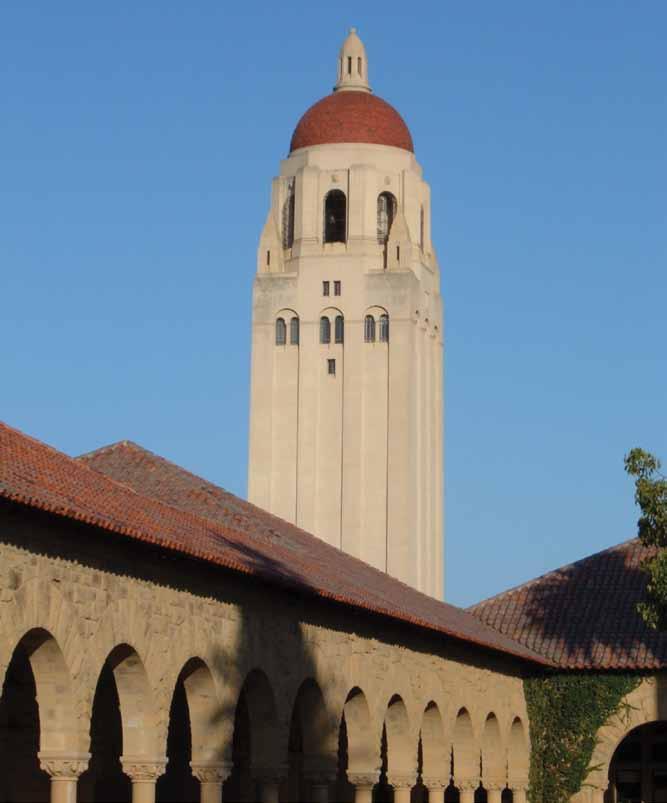
109
After the Peace Corps, Mae came back to the United States She set her sights on a different goal Her greatest dream was to become an astronaut and travel into space She decided to apply to NASA to become an astronaut But the first time she applied, she was not accepted Instead of giving up, she tried again and NASA accepted her the second time! She was one of only 15 people chosen from a group of 2,000 people who wanted to become astronauts!
Her training to become an astronaut was hard She had to get into great shape and train to get used to being free of the effects of gravity in space She also had to study and pass many tests about space travel
Mae Jemison succeeded in both
110 What’s in Our Universe?
An experiment studying the effects of weightlessness

111 What’s in Our Universe?
In 1992, Mae was chosen for a mission on the Endeavour space shuttle A rocket launched the Endeavour into orbit around Earth Mae became the first African-American female astronaut in space!
The mission was to study the effects of weightlessness on plants and animals Mae conducted experiments during the mission with fellow astronaut Jan Davis They collected information that the scientists at NASA could study The mission was a great success
After her successful mission, Mae retired from NASA She became a professor at Dartmouth College, sharing her love of science and space with other students She also started her own company called The Jemison Group, Inc Mae’s company continues to work with people in poor countries, searching for ways that science can help improve these people’s lives Mae Jemison is truly a role model that we can all admire!
112 What’s in Our Universe?
What’s in Our Universe?

113
Mae Jemison achieves her goal of becoming an astronaut.
Chapter Nicolaus Copernicus 14
Do you remember in the very first chapter of this reader you learned that long ago, people believed that the sun moved around Earth? This seemed to make sense Each morning at the start of the day, the sun rose in the east At the end of the day, the sun set in the west—exactly opposite from where it had come up To explain this change, people said the sun moved around Earth This is what the Greeks and other ancient people believed But you also learned in the first chapter that this was not true
About the same time that Christopher Columbus arrived in America, a man named Nicolaus Copernicus was studying math and astronomy at a university in Poland He later moved to Italy where he also studied medicine and law
114 What’s in Our Universe?
Young Copernicus studied math, astronomy, medicine, and law.
What’s in Our Universe?
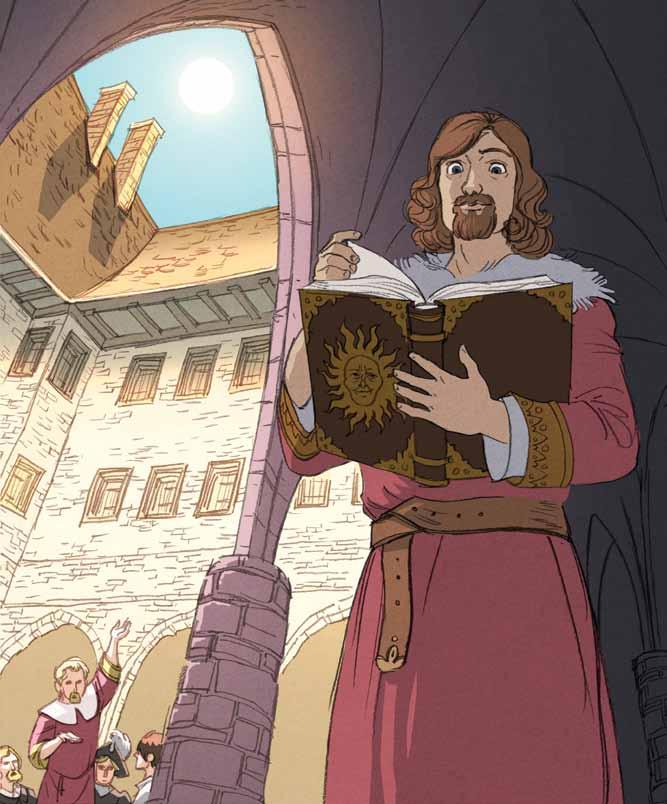
115
But Copernicus’ real love was astronomy He knew that since ancient times, people believed that the sun moved around Earth Copernicus began to carefully observe and record the movement of the sun, planets, and stars After much research, Copernicus decided that the belief that the sun moved around Earth could not be true Copernicus’ observations led him to believe just the opposite! He realized that instead, Earth was moving around the sun! He also believed that as Earth orbited the sun, it also completed a full rotation each day
All of Copernicus’ ideas came from viewing space without the help of a telescope He wrote down what he observed from a cathedral bell tower He also used math to help him prove his point Finally, Copernicus wrote a book explaining his new ideas about how the universe worked His fellow scientists went to work trying to prove him wrong, but they couldn’t Most were amazed by his discovery!
116 What’s in Our Universe?
What’s in Our Universe?

117
Copernicus spent hours observing the movement of the stars, planets, and sun.
However, Copernicus’ ideas were different from what people had believed for thousands of years They believed that Earth and humans were the center of the universe Many of the teachings of the church at that time were also based on this belief Copernicus had dared to suggest that Earth was not the center of the universe Instead, he said, the sun was at the center! Many in the church disagreed with Copernicus’ ideas and spoke out against them So, his beliefs were not widely accepted while he was alive
In fact, even after Copernicus died, the church continued to argue against the view that the sun was at the center of the universe Some scientists agreed with Copernicus’ ideas Galileo agreed with Copernicus and was punished and put in jail for a long time
Today we know, of course, that Copernicus was right It took great courage to speak up and suggest an idea that was so different from what people had always believed But that is how science works Even today, scientists continue to learn new things about the universe, so our knowledge is always changing and growing
118 What’s in Our Universe?
Copernicus argued that the sun, not Earth, was at the center of the universe.
What’s in Our Universe?

119
The Big Bang 15
Have you ever wondered how the universe and our solar system came to be? Astronomers have studied the universe for thousands of years During that time, people suggested many different explanations of how our solar system began
With the help of telescopes, modern astronomers noticed that all of the distant galaxies in the universe seem to be moving outward The more distant the galaxies, the faster they are moving outward Stars are moving away from Earth and so are whole galaxies
In 1929, a scientist named Edwin Hubble discovered this distance versus speed that is now called “Hubble’s Law ” (This is the same “Hubble” after whom the Hubble Telescope is named!)
120 What’s in Our Universe? Chapter
Edwin Hubble discovered that all the distant galaxies in the universe seem to be moving outward.
What’s in Our Universe?
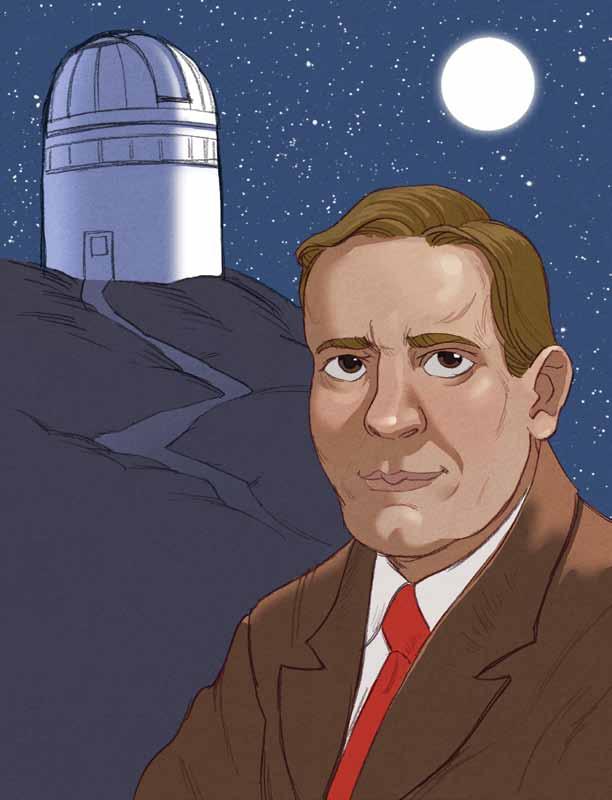
121
Hubble’s observation led scientists to offer explanations of how the solar system started There are many explanations, or theories, about how the universe came to be One recent theory or idea is known as the Big Bang Theory A theory in science tries to explain how something happened or how something works
Three astrophysicists proposed the Big Bang Theory in the 1960s Astrophysicists are scientists who use math to study the universe George Lemaitre, Alexander Friedmann, and Edwin Hubble studied the theories of another scientist by the name of Albert Einstein They used his ideas to develop their explanation of how the universe first started
122 What’s in Our Universe?
Many astrophysicists contributed to the development of the Big Bang Theory.
What’s in Our Universe?

123
They suggested that long ago, the universe and everything in it was once a tiny ball All of the stuff that makes the universe (called matter) was squeezed together into one tiny space Imagine if all the planets and all the stars were squeezed together to fit in your hand That is how tight and tiny the ball was! Scientists think that everything began expanding outward about 14 billion years ago All the matter in the universe exploded out at once! That is why the event is called the Big Bang
When all the matter in the ball began moving out, it was very hot It was hotter than even the hottest star Everything was moving so fast as it expanded that nothing could stick together It was too hot and fast for anything to be like what it is today There were no galaxies, no stars, no planets, and no people
But over time the matter began to cool As the matter cooled and stopped moving so fast, gravity was able to hold little bits of matter together in spheres
These little spheres, with the help of gravity, came together and became the first stars and galaxies Over billions of years of matter moving and growing, the universe became the way it looks today The sun and planets in our solar system formed about four billion years ago
124 What’s in Our Universe?
All matter in the universe expanded out from one tiny point.
What’s in Our Universe?

125
Scientists are continuing to look into space for more clues about the Big Bang There is still a lot to learn about the early universe Scientists sometimes make minor changes to the Big Bang Theory to match what they have learned It is amazing to think how old our solar system is and that scientists are still trying to find out how it all started!
126 What’s in Our Universe?
What’s in Our Universe?
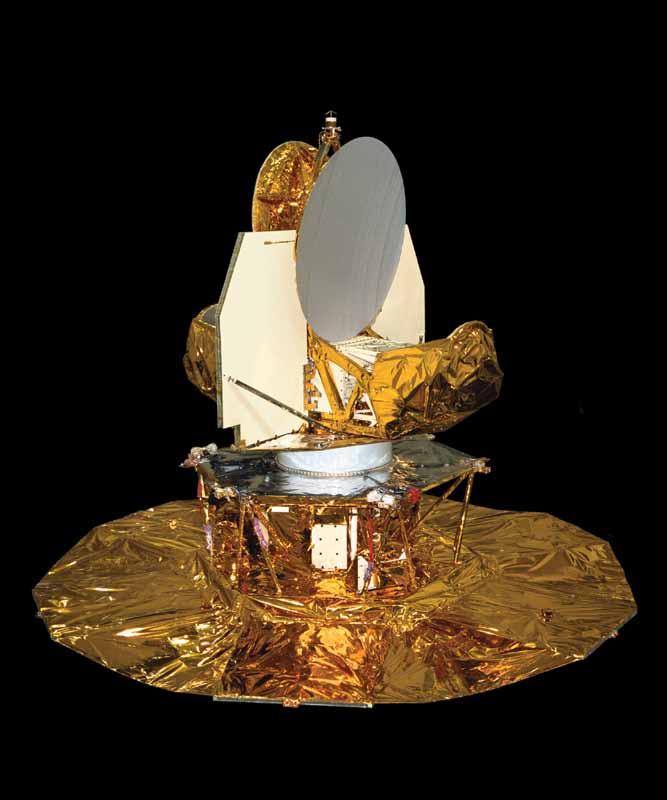
127
This satellite helped scientists learn more about the early universe.
128 What’s in Our Universe?
Glossary for What’s in Our Universe?
AAfrican-American studies—the study of the history, culture, and politics of African-Americans, Americans who have ancestors from Africa
Andromeda Galaxy—the spiral galaxy that is closest to the Milky Way Galaxy
Apollo 11—a rocket ship that took three American astronauts to the moon in 1969
asteroid—a space rock, smaller than a planet, that orbits the sun (asteroids)
asteroid belt—an area between Mars and Jupiter where thousands of asteroids orbit around the sun in a shape like a belt
astronaut—a person who travels into outer space
astronomer—a scientist who studies stars, planets, and outer space (astronomers)
astrophysicist—a scientist who studies the physical characteristics of heavenly bodies (astrophysicists)
129 What’s in Our Universe?
atmosphere—an invisible, protective blanket of air around Earth and other heavenly bodies attraction—when things are drawn to move closer together axis—an imaginary straight line through the middle of an object, around which that object spins
BBig Bang Theory—a scientific explanation of how the universe began billion—a very large number (billions)
booster rocket—one of two parts of a space shuttle that helps launch it into space by overcoming gravity (booster rockets)
C
chemical engineering—a field of study in which scientists use their knowledge of chemistry and how things in the natural world are made and interact comet—a frozen ball of dust and ice that travels through outer space (comets)
130 What’s in Our Universe?
constellation—stars that form a pattern or shape that looks like such things as a person, an object, or an animal as seen from Earth (constellations)
courage—bravery
Eeclipse—the blocking of the light from the sun by another heavenly body (eclipses)
Endeavour—a NASA space shuttle especially—very much, particularly exploration—the study of unknown places or things
Ggalaxy—a very large cluster of billions of stars, dust, and gas held together by gravity and separated from other star systems by a large amount of space (galaxies)
gas giant—one of the large outer planets, Jupiter, Saturn, Uranus, and Neptune, that is composed of mainly hydrogen gas (gas giants)
gravity—a force that pulls things toward one another
131 What’s in Our Universe?
HHalley’s Comet—a famous comet named for British scientist Edmund Halley that is visible from Earth with the naked eye every 76 years
health care—the prevention or treatment of illnesses by trained medical specialists
Hubble Telescope—a large telescope that collects information in space; It was carried into space in 1990 and will be there until 2014
hydrogen—the most common gas in the universe, which is lighter than air and easily catches fire
Iimagine—to pretend international—involving more than one country
Llaunch—to send a rocket into outer space (launched)
132 What’s in Our Universe?
Mmanned—carrying and operated by people matter—the stuff everything in the universe is made of; anything that takes up space
meteor—a piece of rock that burns very brightly when it enters Earth’s atmosphere from space, also called a shooting star (meteors)
meteorite—a meteor that does not fully burn up in Earth’s atmosphere and falls to Earth
meteoroid—a space rock, smaller than an asteroid, that orbits the sun (meteoroids)
Milky Way Galaxy—the galaxy that contains Earth and the solar system in which it lies
naked eye—your eye
NASA—National Aeronautics and Space Administration; an organization in the United States that directs space travel and research
133 What’s in Our Universe?
N
Oobservatory—a place used to observe the sun, moon, stars, and outer space (observatories) orbit—the curved path something in space takes around another object in space; Planets move in an orbit around the sun (orbiting)
PPeace Corps—a group of American volunteers who carry out projects in other countries to help improve the lives of people living there planet—a round object in space that orbits a star (planets)
Polaris—the North Star; the brightest star at the end of the handle of the Ursa Minor/Little Dipper that stays in the same place in the night sky all year long probe—a tool used to explore something, such as outer space (probes)
134 What’s in Our Universe?
Rresearch—the kind of equipment used to collect information through experiments
reusable—when something can be used more than once rotate—to turn about an axis or a center (rotating, rotates, rotation)
Ssatellite—a natural or man-made object that orbits a planet or smaller object (satellites) shuttle—to go back and forth from one place to the next (shuttled) solar system—the sun, other bodies like asteroids and meteors, and the planets that orbit the sun space shuttle—a manned spacecraft used for exploration space station—a manned satellite that is made to be in outer space for a long period of time sphere—an object shaped like a ball (spheres)
135 What’s in Our Universe?
Ttheory—a suggested explanation for why something happens (theories) tilted—slanted or tipped to one side
Uunmanned—not carrying people
Ursa Major—the constellation named by Ptolemy that is also called Big Bear; It includes the Big Dipper
Ursa Minor—the constellation made of seven stars named by Ptolemy that is also called Little Bear; It is the Little Dipper
Vvolunteer—a person who willingly performs a service without getting paid
Wweightlessness—to have little or no weight
136 What’s in Our Universe?
Core Knowledge language arts
series editor-in-Chief
E. D. Hirsch, Jr.
President
Linda Bevilacqua
editorial staff
Carolyn Gosse, Senior Editor - Preschool
Khara Turnbull, Materials Development Manager
Michelle L. Warner, Senior Editor - Listening & Learning
Mick Anderson
Robin Blackshire
Maggie Buchanan
Paula Coyner
Sue Fulton
Sara Hunt
Erin Kist
Robin Luecke
Rosie McCormick
Cynthia Peng
Liz Pettit
Ellen Sadler
Deborah Samley
Diane Auger Smith
Sarah Zelinke
design and graPhiCs staff
Scott Ritchie, Creative Director
Kim Berrall
Michael Donegan
Liza Greene
Matt Leech
Bridget Moriarty
Lauren Pack
Consulting ProjeC t ManageMent serviCes
ScribeConcepts.com
additional Consulting serviCes
Ang Blanchette
Dorrit Green
Carolyn Pinkerton
aCKnowledgMents
These materials are the result of the work, advice, and encouragement of numerous individuals over many years. Some of those singled out here already know the depth of our gratitude; others may be surprised to find themselves thanked publicly for help they gave quietly and generously for the sake of the enterprise alone. To helpers named and unnamed we are deeply grateful.
Contributors to earlier versions of these Materials
Susan B. Albaugh, Kazuko Ashizawa, Nancy Braier, Kathryn M. Cummings, Michelle De Groot, Diana Espinal, Mary E. Forbes, Michael L. Ford, Ted Hirsch, Danielle Knecht, James K. Lee, Diane Henry Leipzig, Martha G. Mack, Liana Mahoney, Isabel McLean, Steve Morrison, Juliane K. Munson, Elizabeth B. Rasmussen, Laura Tortorelli, Rachael L. Shaw, Sivan B. Sherman, Miriam E. Vidaver, Catherine S. Whittington, Jeannette A. Williams
We would like to extend special recognition to Program Directors Matthew Davis and Souzanne Wright who were instrumental to the early development of this program.
sChools
We are truly grateful to the teachers, students, and administrators of the following schools for their willingness to field test these materials and for their invaluable advice: Capitol View Elementary, Challenge Foundation Academy (IN), Community Academy Public Charter School, Lake Lure Classical Academy, Lepanto Elementary School, New Holland Core Knowledge Academy, Paramount School of Excellence, Pioneer Challenge Foundation Academy, New York City PS 26R (The Carteret School), PS 30X (Wilton School), PS 50X (Clara Barton School), PS 96Q, PS 102X (Joseph O. Loretan), PS 104Q (The Bays Water), PS 214K (Michael Friedsam), PS 223Q (Lyndon B. Johnson School), PS 308K (Clara Cardwell), PS 333Q (Goldie Maple Academy), Sequoyah Elementary School, South Shore Charter Public School, Spartanburg Charter School, Steed Elementary School, Thomas Jefferson Classical Academy, Three Oaks Elementary, West Manor Elementary.
And a special thanks to the CKLA Pilot Coordinators Anita Henderson, Yasmin Lugo-Hernandez, and Susan Smith, whose suggestions and day-to-day support to teachers using these materials in their classrooms was critical.
Credits
Every effort has been taken to trace and acknowledge copyrights. The editors tender their apologies for any accidental infringement where copyright has proved untraceable. They would be pleased to insert the appropriate acknowledgment in any subsequent edition of this publication. Trademarks and trade names are shown in this publication for illustrative purposes only and are the property of their respective owners. The references to trademarks and trade names given herein do not affect their validity.
All photographs are used under license from Shutterstock, Inc. unless otherwise noted.
exPert reviewer
Charles Tolbert
writers
illustrators and iMage sourCes
Cover: Shutterstock; Title Page: Shutterstock; 5: Shutterstock; 7: Shutterstock; 9: Shutterstock; 11: Shutterstock; 13: Core Knowledge Staff; 15: Core Knowledge Staff; 17: Shutterstock; 19: Shutterstock; 21: Shutterstock; 23: Shutterstock; 25: Shutterstock; 27: Shutterstock; 29 (top): Shutterstock; 29 (bottom): NASA, Galileo, Copyright Calvin J. Hamilton; 31: Shutterstock; 33: Shutterstock; 35: Shutterstock; 37: Shutterstock; 39: Shutterstock; 41 (top): NASA/JPL-Caltech; 41 (bottom): Shutterstock; 43: Shutterstock; 45 : Shutterstock; 47: Shutterstock; 49: Shutterstock; 51: Shutterstock; 53: Shutterstock; 55: Shutterstock; 57: Shutterstock; 59: Shutterstock; 61: NASA, ESA, N. Evans (HarvardSmithsonian CfA), and H. Bond (STScI); 63: public domain; 65 (top): Shutterstock; 65 (bottom): Shutterstock; 67: NASA; 69 (top): NASA; 69 (bottom): NASA; 71: NASA/NASA History Office/Kennedy Space Center; 73: NASA; 75: NASA; 77: NASA; 79: NASA; 81: NASA; 83: Shutterstock; 85: NASA; 87: NASA; 89: NASA/Johnson Space Center; 91: Shutterstock; 93: NASA; 95: ISS Expedition 28 Crew, NASA; 97: NASA; 99: NASA; 101: NASA; 103: NASA; 105: NASA; 107: NASA; 109: BrokenSphere / Wikimedia Commons / Creative Commons Attribution-Share Alike 3.0 Unported, http://creativecommons.org/licenses/by-sa/3.0/deed.en / Modified from Original; 111: NASA; 113: NASA/Johnson Space Center; 115: Jed Henry; 117: Jed Henry; 119: Jed Henry; 121: Jed Henry; 123: Jed Henry; 125: Jed Henry; 127: NASA / WMAP Science Team
Regarding the Shutterstock items listed above, please note: No person or entity shall falsely represent, expressly or by way of reasonable implication, that the content herein was created by that person or entity, or any person other than the copyright holder(s) of that content.
Core Knowledge Staff, Fritz Knapp
What’s in Our Universe? Unit 7 Reader Skills Strand gr A de 3 The Core Knowledge Foundation www.coreknowledge.org
















































































